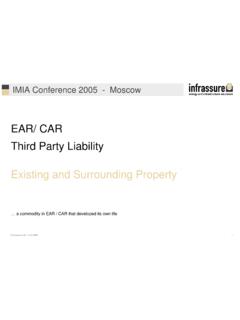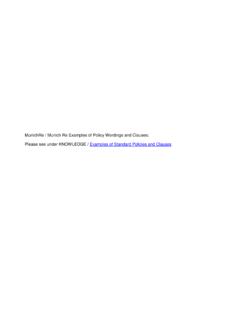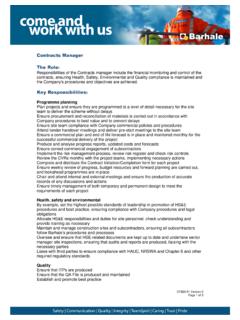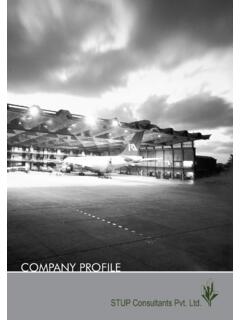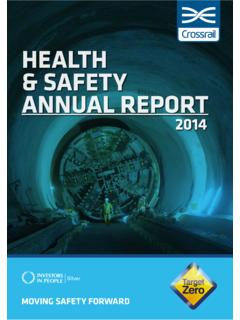Transcription of Code of Practice for Risk Management of Tunnelling Works
1 TII30 January 2006A CODE OF Practice FORRISK Management OFTUNNEL WORKSP repared byThe International Tunnelling Insurance GroupA Code of Practice for Risk Management of tunnel WorksContributors to this CodeITIG (Insurance Members)P BraverySwiss ReS CrossZurich Global CorporateR GallagherAllianz AGO HautefeuilleScorH ReinerMunich ReM SpencerZurich Global CorporateChair in ITIGP SmithAllianz Global risks UKP SmithMunich ReA StolfaAssicurazioni GeneraliH WannickMunich ReA Code of Practice for Risk Management of tunnel WorksPage 3 of 28 January OF THE WITH THE ASSESSMENT AND ROLE AND DEVELOPMENT CONTRACT PROCUREMENT STAGESCHEDULE 1 APPLICABLE LEGISLATION, STANDARDS AND CODES and Terms used in this of Deliverables for use by Contract InsurersNote on drafting:Where this Code of Practice uses the words 'shall' and 'must', the procedureto which it applies is compulsory.
2 Where the word 'should' is used then theprocedure is recommended best Code of Practice for Risk Management of tunnel WorksPage 4 of 28 January 2006 NOTE AND ACKNOWLEDGEMENT BY ITIG TO BTS & ITAThis code has been based on The Joint Code of Practice for Risk Management of tunnel Works in the UK which wasprepared jointly by the British Tunnelling Society and the Association of British Insurers and published by the BritishTunnelling Society in September code has been subsequently modified after discussions with the International Tunnelling Association and theInternational Association of Engineering Insurers, notably to recognise that some of the provisions in the originalJoint Code would not be appropriate or legal in all nations, regions, or cities which would require specificamendments to the is clear that the code is intended as a tool to promote best Practice in risk Management and reduce the occurrenceof accidents.
3 It is difficult for one document to be uniformly applied to all geographical and work situations. Finaladoption of all or parts of the code should be resolved by the interested agreement of the British Tunnelling Society for the preparation and subsequent publication of this code isgratefully BY THE ITAITA supports the principles and the spirit of the use of Risk Management and generally agrees with the principles ofthe code. ITA supports ITIG in this initiative to ensure that Risk Management principles are incorporated into theimplementation of tunnel and underground BY THE IMIAThe International Association of Engineering Insurers (IMIA) fully supports the principles of Risk Managementaddressed in this Code. IMIA supports the initiative of ITIG and will display this Code of Practice in the IMIA WebSite: Code of Practice for Risk Management of tunnel WorksPage 5 of 28 January OF THE objective of this Code is to promote and secure best Practice for the minimisation and Management ofrisks associated with the design and construction of tunnels, caverns, shafts and associated undergroundstructures including the renovation of existing underground structures, referred to hereafter as TunnelWorks.
4 It sets out Practice for the identification of risks , their allocation between the parties to a contractand Contract Insurers, and the Management and control of risks through the use of Risk Assessmentsand Risk identified in italics in this Code are defined/described in Appendix is intended that this Code applies to Contractors All risks Insurance and Third Party LiabilityInsurance for tunnel Works . The adoption or recognition of this Code is voluntary. ContractInsurers are free to decide their own policy on risk Management and underwriting and offer differentpolicy conditions to their scope of this Code applies to the project development, design, contract procurement for constructionand construction stages of tunnel Works , wherever these may be carried out geographically, theoperation of tunnel Works so far as any stipulated maintenance period and the impact of tunnel Worksconstruction on Third Parties including Code excludes the operational performance of tunnels and underground structures other than thatincluded within any stipulated maintenance period under a construction Code is intended to operate in parallel with and does not derogate from.
5 A) statutory duties, responsibilities and requirements of Local National Legislation relating to health andsafety, the design and subsequent implementation of construction activities in respect of TunnelWorks;b)Local National Standards and/or Codes of Practice appropriate and applicable to design andconstruction of tunnel Works including those relating to workmanship and materials;c)recommendations for and guidance on health and safety practices as set out in British StandardBS6164:2001 (Code of Practice for safety in Tunnelling in the construction industry) and anysubsequent revisions or equivalent appropriate and applicable Local National Standards and/orCodes of Practice . the provisions of the Code are more extensive and/or more onerous than any recommendations,statutory requirements, duties, responsibilities or Standards/Codes of Practice set out in Clause , the requirements of the Code shall apply in the absence of specific Local National Legislation and/or Local National Standards and/orCodes of Practice dealing with such matters as set out in Clause above, the Insured shall notifyContract Insurers of the provenance of Standards and/or Codes of Practice that will apply on a TunnelWorks project which relate to health and safety practices (including those applicable to the provision andoperation of plant and machinery), design and construction (including materials and workmanshipmatters).
6 Insured shall provide the statutory legislative requirements, Standards and/or Codes of Practice toprevail during the tunnel Works in Schedule 1 to this Code of Practice for Risk Management of tunnel WorksPage 6 of 28 January suggested 'Schedule of Deliverables' for use by Contract Insurers is given in Appendix B. It should beacknowledged, however, that the schedule as presented cannot and shall not be seen as exhaustive. The'deliverables' on any particular tunnel Works project will be determined by the project requirements, asset out in Contract WITH THE with the Code as it applies to construction projects involving tunnel Works , should minimisethe risk of physical loss or damage and associated delays. It follows that Insurance contracts coveringTunnel Works should benefit from provisions which enable Insurers to enforce the requirements of Insurers recommend compliance with the Code as far as is practicable on all projects wherethe value of tunnel Works is US$ million or above.
7 For projects where the tunnel Works element isless than US$ million, but where there is significant identified risk to third parties, the Insured shouldbring this matter to the attention of the Contract Insurers during the agreement of the terms ofInsurance cover. This stipulation should not be seen as reducing, qualifying or definitively defining theInsured's duties of disclosure under the Contract of Insurers will reserve the right to enter and inspect any tunnel Works insured under anInsurance Contract and/or related documents within a reasonable time once a request is made. Thepurpose of any inspection is to assess compliance with the Insurers may decide to add a specific provision or endorsement to their Policy to ensurecompliance with the Code. There is no mandatory form of such provision or endorsement and norequirement for any such provision or endorsement to be used.
8 Insured should always take advice fromtheir Insurance Advisers as to the insurance implication of non-compliance with the Hazard identification and the Management of risk to ensure their reduction to a level 'as low as reasonablypracticable' (ALARP) shall be integral considerations in the planning, design, procurement and constructionof tunnel Works . So far as it is reasonably practicable, risk should be reduced through appropriatedesign and construction Responsibility for risk Management shall be explicitly allocated to relevant parties to a contract so that theyare addressed adequately and appropriately in the planning and Management of a project and thatappropriate financial allowances can be The use of a formalised Risk Management procedure shall be employed as a means of documentingformally the identification, evaluation and allocation of RISK ASSESSMENT AND Risk Management is the systematic process of:A Code of Practice for Risk Management of tunnel WorksPage 7 of 28 January 2006a)identifying hazards and associated risks , through Risk Assessments, that impact on a project'soutcome in terms of costs and programme, including those to third parties.
9 B)quantifying risks including their programme and cost implications;c)identifying pro-active actions planned to eliminate or mitigate the risks ;d)identifying methods to be utilised for the control of risks ;e)allocating risks to the various parties to the the purpose of this Code, 'Risk' is defined as the combination of the consequence (or severity) of a'hazard' and its likelihood, that is:Risk is a function of the consequence/severity of a hazard and the likelihood of occurrence of the 'hazard' is defined as an event that has the potential to impact on matters relating to a project whichcould give rise to consequences associated with:a)health and safety;b)the environment;c)the design;d)the programme for design;e)the costs for the design;f)the construction of the project;g)the programme for construction;h)the costs associated with construction;i)third parties and existing facilities including buildings, bridges, tunnels, roads, surface and subsurfacerailways, pavements, waterways, flood protection Works , surface and subsurface utilities and allother structures/infrastructure that shall be affected by the carrying out of the Hazards shall be identified and evaluated on a project-specific basis and their consequent risks shall beidentified and quantified by Risk Assessments through all stages of a project (Project DevelopmentStage, Construction Contract Procurement Stag,, Design Stage,, Construction Stage andoperational stage for any stipulated maintenance period).
10 The nature of the hazards (and hence their consequent risks ) will be dependent on the stage of a projectunder Risk Risk Assessment is the formalised process of identifying hazards and evaluating their consequence andprobability of occurrence together with strategies as appropriate for preventative and contingent Risk Assessments required at each stage of a project shall be summarised in appropriate RiskRegisters. Risk Registers shall clearly indicate the party responsible for the control and henceA Code of Practice for Risk Management of tunnel WorksPage 8 of 28 January 2006management of an identified risk (respecting any Contract responsibilities and liabilities), as well ascontingency measures available for the mitigation of the The parameters to be used in the assessment of risks , in terms of probability of occurrence of a hazard andits severity of impact/consequence on cost, programme, environment, third parties and existing facilitiesshall be both project specific and appropriate to the project stage under Insurance should not be considered as a contingency or mitigation measure in risk assessments forTunnel Risk The processes of Risk Assessment and the subsequent preparation of Risk Registers are required toidentify and clarify ownership of risks and shall detail clearly and concisely how the risks are to beallocated, controlled, mitigated and managed.




